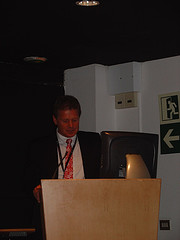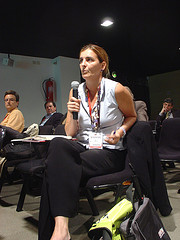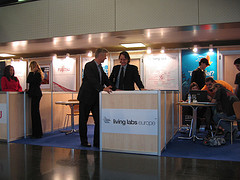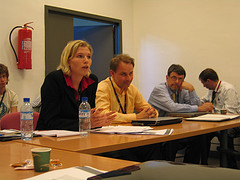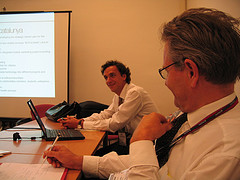Paper presented by Prof Jan Annerstedt and Sascha Haselmayer at eChallenges 2006, Barcelona October 26th 2006.
A more mobile Europe? - User demands for seamless mobility.
The vast and still growing supply of relatively cheap and effective information and communications technology (ICT) has stimulated demand for new solutions to achieve mobility, even seamless mobility. To meet this demand, how to exploit better what the new and existing technology could offer
How to foster – at the very early stages of the product cycle – user-oriented or user-centered mobile applications for business firms and for public agencies, for professionals as well as for ordinary citizens?
How to face the quest for novelty among ICT applications with regard to actual user needs, when many current applications in a world of increased mobility have emerged unexpectedly from the twists and turns of invention as digital technology was combined with other technology, often driven by advanced user-demands for new mobile applications.
These three questions triggered our curiosity as researchers and our energy as ‘doers’ to engage ourselves in companies and city regions that appear to be more prominent than others in developing specialized software and other technology in support of mobility. This document reflects some of our analytical insights and practical experiences (as network members of Living Labs Europe; www.livinglabs-europe.com), when looking more deeply into the ‘clustering of competencies’, which have shaped pioneering ICT applications to enhance mobile services across the continent.
Information and communication technology represent powerful tools for our minds. Yet, while the technological capacities to store enormous amounts of data continue to increase and the capabilities to access and process data by technical means are amplified, our cognitive abilities do not always appear to improve by the same speed. Less and less, the limitations of access to data and processing of data are technological and economic (the costs for data storage are approaching zero). More and more, the real boundaries for transforming data to information and knowledge rest in our minds. If our mindsets develop slowly in relation to the new technological means in our hands, the conditions for creating and shaping innovations may be profoundly affected. Easy access to ICT or not, we may in fact be slow to detect the many new qualities of what the European Commission prefers to call the emerging ‘Information Society’.
‘mWatch’: Benchmarking mobile applications across Europe
By the engagement in companies and city regions, Living Labs Europe came to identify, analyze and expose some of Europe’s most forward-looking and promising developments with regard to new mobile applications across sectors. These findings have been reported elsewhere and will continue to be reported.
The aim of the so-called ‘mWatch’ (Mobility Watch) reports is to encourage co-operation among leading firms and institutions in various cities, other locations and regions across Europe to become more actively involved in the shaping of new solutions, based on wireless information and communications technology. By systematic mapping of pioneering projects and by disseminating case-based insights into successful mobile applications, the ‘mWatch’ reports are to provide inspiration for business venturing, regional collaboration, user-centered innovation activity, and, more generally, an improved utilisation of existing technology, competences and resources. An ‘mWatch’ exercise should provide better understanding of framework conditions leading to success for business companies and for ‘clusters of competencies’ in the information and communication industries and supporting institutions. More specifically, how to foster and manage innovation environments that allow for users to help create new applications? How to link up functionally with R&D centers, universities, high-tech firms, other business firms and supporting institutions in processes of invention, prototyping and design of computer software as well as physical products?
Are Living Labs a solution for Europe’s innovation problems?
In Europe’s ‘knowledge-based economy’, one of the most vitalizing modes of fostering user-led or user-centric innovations is the so-called Living Labs. A Living Lab is an open innovation space, which recognizes the design and development roles of users or user communities even in the early phases of an innovation process. A Living Lab contains a set of facilitating instruments to sustain effective interactions between the producers and users. When focused on information and communications technology, the Living Lab could enhance truly inventive uses and help sensing new products and processes. Professional users as well as amateurs may play significant roles in identifying new needs and in shaping new designs and applications.
A Living Lab in the European information-based society is much more than a straightforward testbed for producers and users of, e.g., new mobile solutions. There could be a specialized testbed within the Living Lab. But there will only be a Living Lab, if it allows easy access for users to become actively engaged in the shaping of new solutions. Based on user needs and interactive engagement of users, a Living Lab of the sort we know should foster imaginative and original applications of state-of-the-art information and communications technology. Currently, there are three generations of Living Labs, increasingly sophisticated as user-centered innovation environments.
The First Generation Living Lab was invented by architects and engineers interested in co-developing with future residents in an already existing building to be better adapted to new user needs. Here, users were invited to co-design an apartment or other living quarters during the final stages of the construction period. New methodologies for participatory design processes are developed with regard also to other buildings and combinations of buildings.
The Second Generation Living Lab was invented by companies involved in the shaping of new work environments within a business firm, an institution, a network of professionals, etc. Often called a Collaborative Working Environment, this generation of Living Labs engages user groups to co-develop new mobile solutions. Using collaborative working tools in an ICT context, the Second Generation Living Lab could become a genuinely interactive working environment open to experiments with, e.g., new mobile solutions.
The Third Generation Living Lab:
In its latest version, a Living Lab has evolved in a city area that operates as a full-scale urban laboratory and proving ground for prototyping and testing new technology applications in real time. Such a Living Lab helps generate and foster innovation processes that go beyond what could be achieved by a single entrepreneur, firm or other organization.
The Third Generation Living Lab is part of a wide cluster of competencies, but remains a future-oriented user-related organization. This Living Lab generation forms part of the wider urban or regional spaces. Here, inventive firms, institutions and organizations as well as individual users and user groups can benefit from all the features of a resource-rich city or regional environment. It could also be functionally linked to research and experimental development.
Third Generation Living Labs: Managed for a wider community
Regardless of the advancements of the three generations Living Labs, all Living Labs must strive to become an interactive innovation environment that attracts creative users or groups of users to work with producers. The Living Lab should stay open also to inventive firms, institutions and other organized interests.
To effectively engage users in participatory design and development, a Living Lab should operate as a demand-driven greenhouse for invention and sustain creative competencies among the Living Lab firms and other stakeholders. If well managed, a Living Lab will constantly help shorten the time from idea to marketable product.
To remain successful, a Third Generation Living Lab organization must be well managed. The local Living Lab organization should include a commitment by a stakeholder group, relate actively to selected user groups, and be led by an effective management team. As an organization dedicated to innovation and ‘intelligent learning’, a Living Lab could operate relatively autonomously by becoming a self-funding center (such as a foundation, company, consortium, etc.).
Third Generation Living Labs that operate, or prepare to operate in European cities, typically focus on applications of information and communications technology and other information society technologies. However, other areas of technology applications are not uncommon among Living Labs. Ideally, the Third Generation Living Lab will be part of a community-building effort that facilitates invention and a widespread adoption of a new, usable technology.
Since many years, companies and institutions benefit from a frequent use of full-scale test beds located across Europe. A few of these test beds have been re-tooled and expanded to include also design processes, where potential users of the emerging applications are directly involved even before the final product has become a prototype. A Living Lab is always covering functions that go beyond the test bed function. Ideally, a Living Lab should target new means and methods for generating inventiveness among users, help sustain innovation processes where users are involved and mobilize entrepreneurship to create new ventures in business and society.
While working on his 2005 book Democratizing Innovation, Eric von Hippel found that users’ abilities to develop new, high-quality products and services for themselves are getting enhanced radically and rapidly. “Steady improvements in computer software and hardware are making it possible to develop increasingly capable and steadily cheaper tools for innovation that require less and less skill and training to use. In addition, improving tools for communication are making it easier for user innovators to gain access to the rich libraries of modifiable innovations and innovation components which have been made accessible in the public domain. The net result is that rates of user innovation will increase even if users’ heterogeneity of need and willingness to pay for ‘exactly right’ products remain constant.”
User-driven innovation environments
Who needs local, user-driven innovation environments, when there seems to be a steady stream of new products from globally operating business firms? Why make a case for Living Labs, where users are key players, when producers typically are in lead positions, trying hard to shape the economic and other impacts of today’s information and communication technology? These questions do not really consider where many of today’s ‘Information Society’ technologies and applications are actually generated. We must not forget ground-breaking applications, driven and shaped by user-needs, such as those of Linux and the Open Source movement! The phenomenon of user-driven and user-centric innovation with regard to ‘Information Society’ technologies is becoming a general phenomenon across Europe and in some other parts of the world. This phenomenon is growing rapidly, so it seems, along with advances in computing and communications.
Claims that user-centric innovation is becoming both an important rival to and an important feedstock for manufacturer-centered innovation in many fields. One such dualism – (A) being user-driven and, at the same time, (B) becoming increasingly important for relatively less inventive corporations – is exploited by the inventors and organizers of Living Labs. Users (especially ‘lead users’) and user communities are gradually attaining more substantial roles as true inventors and entrepreneurs. On the other hand, corporations – particularly engineering and manufacturing firms – tap into the locally-anchored innovation processes to transform pioneering products into mass market produce.
The innovation communities could be wide in their range of activities, or they could be highly specialized, serving as collection points or repositories of information related to certain categories of technologies or innovations.
Ideally, a Living Lab is made up of individuals and interconnected firms, institutions and other organizations. They interact by face-to-face communication and by electronic and other means of information and knowledge transfer. However, to be successful they may not need to incorporate all the qualities of a community of interpersonal ties that will “provide sociability, support, information, a sense of belonging, and social identity,” even if this could make a Living Lab even more effective.
Full-scale urban experiments: Third Generation Living Labs
Given the waves of technological change due to the information and communications technology of our generation, how to really create optimal conditions for shaping the technology applications to fit user needs and related organizational, social and cognitive changes? And, how to provide the resources for an innovation environment that is well adapted to ‘democratized’ opportunities to create?
As a managed innovation environment, a Third Generation Living Lab is a city area that operates as a full-scale urban laboratory and proving ground for prototyping and testing new technology application and new methods of generating and fostering innovation processes in real time. Users, including professional users, should play a significant role in identifying needs, shaping applications, and creating effective interactions between the inventive producers and users of technology for truly inventive uses.
Third Generation Living Labs that already operate, or are starting to prepare operations in various European cities, typically focus on original applications of information and communications technology and other such ‘Information Society’ technologies. Currently, Living Labs initiatives have been taken by groups of stakeholders in cities like Almere (the Netherlands), Barcelona (Spain), Copenhagen (Denmark), Lund-Malmö (Sweden), Helsinki (Finland), London (United Kingdom), Mataro (Spain), San Cugat (Spain), Sophia-Antipolis (France), Stockholm (Sweden), Tallinn (Estonia), Torino (Italy), Bergslagen/Grythyttan (Sweden), and Kalmar/Västervik (Sweden).
Each Living Lab organization should include a commitment by a stakeholder group, have a management team, operate as a self-funding center (company, foundation, etc.) and sign an agreement based on the principle of sharing Living Lab experiences and practices across Europe.
Judging from current Living Labs experiences (see below), when the Living Labs are perceived and managed as local innovation environments or innovation communities, they actually do flourish when at least some actors in them continue to innovate and voluntarily share their insights and reveal parts of their innovations. The Living Lab becomes even more dynamic and may also become an effective hub or transaction point in a wider network, if others find the information revealed of special importance to them as inventors and entrepreneurs.
Typically, in recent years, the capability and the information needed to innovate effectively are becoming widely distributed. The most effective Living Labs are designed for many types of users and implemented as local nodes within European and even global networks. From an overall policy-point of view, the “traditional pattern of concentrating innovation-support resources on just a few pre-selected potential innovators is hugely inefficient. High-cost resources for innovation support cannot be allocated to ‘the right people’, because one does not know who they are until they develop an important innovation. When the cost of high-quality resources for design and prototyping becomes very low – which is the trend … – these resources can be diffused widely, and the allocation problem then diminishes in significance. The net result is and will be to democratize the opportunity to create.”
Living Labs Europe is the cross-border inter-city organization in Europe, currently coordinated by Interlace-Invent, a research-based consultancy firm in Copenhagen with operations across Europe. Living Labs Europe is managed as a consortium of innovative city-based projects across the European continent, pioneering advanced applications, shaping purposeful uses of leading-edge mobile information and communications technology. Each Living Lab agrees to be a node in a European network and share information and experiences and, if possible, develop cross-border projects with other Living Labs.
A Living Lab project should be competitive and global in orientation, yet locally anchored. It should be interactive in all its workings, involving advanced users as well as producers of technology and applications. Typically, a Living Lab project is to be supported jointly by individuals, business firms, public sector agencies and research institutions.
What lessons for policy-makers?
In today’s Europe, user-driven innovation seems to be the ‘name of the game’, especially for information and communications technology. Not long ago, the situation was different. For several decades, the typical innovation process underpinning the European ‘information society’ was to push new technology applications into the market. The major innovations, based on ICT, were invented by companies, then tested, adjusted and launched on the market, while trying to convince the user to buy and to adapt to the dominant designs.
Now, as time to market is faster and product cycles shorter, the design and development processes behind new ICT application must adapt better to the user’s needs from the very beginning of the innovation process. As technology applications have become cheaper and more user-centric, companies ask users to become co-designers even at early stages of invention, design and prototyping.
What’s the main lesson for policy-makers?
Politicians should be more aware that the influence of users at all stages of the innovation process tends to increase. They should understand better that the tools for design of ICT applications have become interactive and much more open to a broader involvement of non-specialists. Moreover, the typical environments for innovation, based on ICT (even within large companies), have become more accessible and sensitive to user-producer interaction. And, generally, companies have been forced to be more responsive to demands among various user groups, especially to such user groups that are likely to signal early market demands.
Users involved in co-design or participatory design could be of many kinds. As we have already seen in the previous chapters of this book, users could be groups of professionals, leading-edge companies, tourists and business visitors, students at universities, organizations of elderly citizens, etc. As long as the user groups are able to indicate their needs and to advance interactively their demands during a design process, the user groups will constitute a rich resource-base for the professional designers and product developers.
The shift towards the user – and towards new user demands – and the opening of new market domains for ICT solutions should affect policies at all levels. Policies must be changed form being primarily supply-side oriented to become more demand-led. In short, policies must become more sophisticated and certainly more sensitive to the new and more interactive arenas of innovation in the cities and regions and across the European continent.
For example, medical doctors, nurses and patients are formulating new demands for advanced services based on new ICT. Rescue workers are actively involved in the development of ICT-based logistical services, which change their work organization and advance the level of speed. Students, teachers and other educators have become co-designers of new way of interactive training and of new pedagogical instruments. Many other user groups play similar roles while becoming advocates in fostering new innovation. This book contains dozens of leading-edge solutions, where users are co-designing and co-developing pioneering mobile solutions, based on advanced applications of ICT.
European policies at the local, national and continental level should become more responsive to the issues of creativity among users, to entrepreneurship and to user-centered and even user-led innovation.
The ‘Lisbon Agenda’ and ‘i2010’: Need for advanced instruments?
The Lisbon strategy to make Europe “the most competitive and dynamic knowledge-driven economy” may need more advanced instruments to reach its many goals and objectives by 2010. For information and communications technology, one instrument has been a set of overall policies packaged as “eEurope” (in various versions) and, more recently, “i2010”.
“i2010” stands for a grouping of proactive policies to harness the potential of the digital economy to deliver growth, jobs and modern, on-line public services. “i2010” also provides tools for good governance. As such, it has been called by the European Commission a “key component of the EU’s renewed Lisbon strategy for growth and jobs”.
In the policy documents for “eEurope” and “i2010”, the information and communication technologies are described as a powerful driver for economy-wide productivity, growth and jobs – and “arguably Europe’s best-bet investment for the future”. What is missing, however, in these policy documents, is a full recognition of the increasingly important demand-side of the development towards a ‘knowledge-driven’ economy and ‘information-based’ society.
“Creating an Innovative Europe” cannot be achieved simply by straightforward policy means, but must involve citizens, companies and institutions as users and, ultimately, as the real drivers of creativity and innovation. Policy-induced supply of services and related infrastructure has many limitations.
Using the Living Labs Europe network as example, where some 22 cities are exposing pioneering efforts by individuals, users groups, small and medium-sized companies, etc., a more elaborate and sophisticated policy framework could be developed at the European, regional and local levels.
The Vision of Living Labs Europe
According to Interlace-Invent, the vision of the Living Labs Europe is to have collaborating Living Labs across the whole of Europe. Each Third Generation Living Lab should have a special profile and each should be enhanced by unique combinations of inventive resources that complement resources of the other Living Labs. They are to be anchored in communities that aim for sustainable development and reach out for social inclusiveness. The mosaic of European Living Lab resources for invention, entrepreneurship and innovation should reflect the diversity as well as the unity of modern Europe. Taken together the Living Labs will become a powerhouse of inventiveness and innovation in support of the European ‘information society’.
Ultimately, the Living Labs in Europe should harness the cultural and historical diversity of Europe as an asset for innovation, benefit from creativity while effectively promoting the use of unique human capabilities and resources across the whole continent. The thrust should be to foster close collaboration across industries, public-private partnerships, geographical proximity, technology, citizens and communities and to harvest synergies across disparate areas of innovation.
Focused on mobile applications of information and communications, the Third Generation Living Labs should help propel Europe to the forefront of advanced applications of information and communications technology and related innovation.
[1] When we talk about the ‘Information Society’ and a more knowledge-intensive economy, we often forget that the conventional indicators of invention, innovation and other change seldom depict conceptual and other cognitive changes among individuals and among firms, institutions and other organizations. We need to apply more adequate indicators to reflect advancements in the ‘intellectual capital’ of an institution or in the ‘intangible goods and capabilities’ of a business firm.
[2] Asplund, Christer, Arna Jazic, Kristina Lundevall, mWatch: A Survey of Mobile Readiness in the Baltic Sea Region 2003, Copenhagen: Baltic Development Forum, 2003. Interlace-invent: mWatch Catalunya: A Survey of Mobile Readiness in the Cities of Barcelona, Mataró, and San Cugat and Their Regional Context, Barcelona and Copenhagen: Interlace-Invent, 2005. An mWatch Europe book is set for publishing in November 2006, assessing Mobile Readiness in 22 European cities and presenting nearly 100 pioneering project cases.
[3] Hippel, Eric von, Democratizing Innovation, Cambridge, MA: MIT Press, 2005, p. 121.
[4] Hippel, Eric von: “Democratizing Innovation. The evolving phenomenon of user innovation”, Cambridge, MA: MIT, unpublished paper, 26 pp.
[5] Hippel, Eric von, Democratizing Innovation, Cambridge, MA: MIT Press, 2005, p. 95.
[6] Wellman, B., J. Boase, and W. Chen. “The Networked Nature of Community On and Off the Internet”. Working paper, Centre for Urban and Community Studies, University of Toronto, 2002, p. 4.
[7] Hippel, Eric von, Democratizing Innovation, Cambridge, MA: MIT Press, 2005, p. 123.
